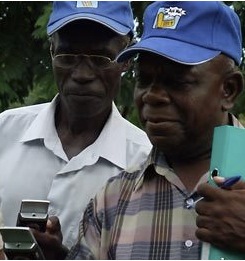This month’s Technology Salon ICT4Ag – Enriching rural coffee farmers via iPads raised a couple of eyebrows from the outset. How can Exprima Media and Sustainable Harvest realistically improve rural coffee farming via iPads?
Initially, it struck me as another attempt to use the latest and greatest technology to tackle longstanding challenges within the value chain, rather than making use of simple and often effective locally generated tech as we have seen with M-Pessa and other innovations.
But there’s more to this project than merely exporting a glitzy trend to coffee farmers and suppliers in far-flung places. Two features appeal to me most: a) the range and utility of the apps; and b) the business model.
Relationship Information Tracking System App
Exprima Media and Sustainable Harvest partnered to develop a suite of traceability and efficiency tools called a Relationship Information Tracking System (RITS apps). The RITS Producer app promises to rapidly improve the operations of coffee co-ops. It functions as a set of supply chain management tools designed to record and track who produced specific quantities of coffee, how they produced it, how it is milled and where it ends up.
This is transformational because logistics is one of the more intractable challenges in the value chain. These traceability functions will enable better quality control because farmers who need to improve production practices can be pinpointed and aided.
The suite of apps also tackles the need for improved training opportunities for coffee farmers and co-op personnel. The RITS Ed app delivers instructional content in video format. Video is a great educational tool because it eliminates the risk of lessons being lost in translation. This exposure to best practices in agronomy, organic compost production, financial literacy among other topics, is likely to improve the quality and quantity of crop yields. To top this off, there’s the RITS Matrix app which simplifies and walks coffee farmers through the often complex organic certification process.
The RITS app design highlights the value of an anthropological approach to ICT4D. The apps were specifically fashioned for cross-cultural use (varied languages, cultural and industry imperatives considered).
Furthermore, the iPad was chosen because its the most intuitive and rugged platform to get the big benefits of computing (automation, info sharing) in the hands of farmers. The simplicity of the user interface also enhance usability by those with limited computer literacy, thereby reducing the need for heavy investment of scare resources (money and time) in training.
RITS App Business Model
However, it is the business model that appeals to me most. According to the project pioneers, “iPads are not expensive toys, they are a business tool”. The iPads are expected to pay for themselves in increased co-op productivity (supply chain management and higher quality coffee).
The project doesn’t aim to get an iPad in the hands of every coffee farmer. In fact, the aim is to place it within existing infrastructure. For instance, equipping cooperatives and extension centers, which will enable greater support for farmer training, advisory services, cooperative planning and management.
Though still a centralized model, this approach tackles the seminal issue of affordability. While the cost of an iPad might be onerous for an individual coffee farmer, a co-op would fare better: Two bags of coffee weighing roughly 300 pounds, contributed by a large group, is equivalent to the cost of an iPad.
But the issue of cost goes deeper. App creation, especially on the iPad, is still expensive. The suite of RITS apps boasts a price tag of several hundred thousand—far too expensive for the co-ops to afford. Sustainable Harvest is looking to subsidy from its partners (software developers, coffee buyers etc) to combat this.











































